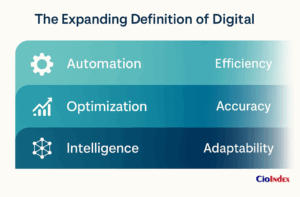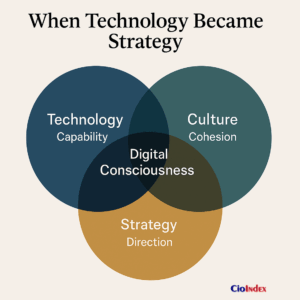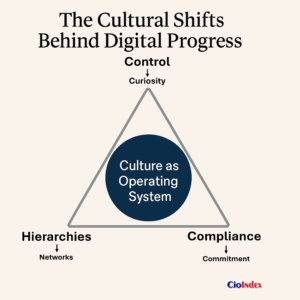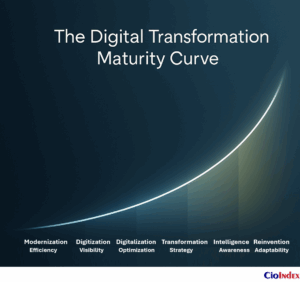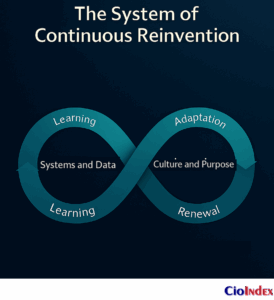The Turning Point: When IT Modernization Became Transformation
The story of digital transformation begins not with artificial intelligence or cloud computing, but with something more familiar — the pursuit of modernization. For decades, organizations invested in technology to automate, streamline, and standardize. The objective was efficiency: faster systems, lower costs, fewer errors. IT was the engine room of progress, but it was also isolated — a function, not a force of strategy.
In the foundational article “Digital Transformation: What It Is, Why It Matters, and How It’s Reshaping Business,” we explored how transformation redefines how value is created and sustained. That redefinition didn’t emerge overnight. It was forged through years of technological progress — from the quiet march of IT modernization to the realization that true competitiveness depends on how intelligently an enterprise evolves.
By the early 2000s, modernization had become synonymous with progress. Enterprises replaced legacy infrastructure, migrated to enterprise resource planning systems, and digitized paper-based workflows. Even as these initiatives delivered measurable efficiencies, they failed to alter the core architecture of value creation. Businesses were faster but not fundamentally different.
Then the world changed. The rise of mobile computing, social platforms, and cloud ecosystems collapsed the boundaries between business and technology. Data became the new raw material of advantage, and customer expectations reset overnight. Suddenly, speed alone was insufficient. Agility, intelligence, and experience became the new metrics of competitiveness.
The realization was profound: modernization could no longer be confined to IT. It had to become organizational. The systems being upgraded were not just servers and software — they were the foundations of how enterprises sensed, decided, and delivered. The conversation shifted from how to update technology to how to reinvent the business itself.
What began as incremental improvement became existential transformation. The turning point was not a single innovation, but a mindset shift: technology moved from the periphery of strategy to its center. The purpose of IT evolved from running systems to enabling continuous reinvention.
Modernization built capability; transformation builds possibility.
From Automation to Intelligence: The Expanding Definition of Digital
When organizations first embraced automation, digital meant replication — replacing manual work with machine precision. The mission was productivity, and success was measured in cost savings, consistency, and speed. From factory floors to finance departments, technology promised control through standardization.
As systems became connected and data-rich, efficiency alone ceased to be a source of advantage. Competitors could adopt the same tools and achieve similar gains. What once differentiated soon became universal. The question shifted from how fast can we work? to how intelligently can we learn? Digital capability began to evolve from automating labor to amplifying intelligence — transforming technology from a tool of efficiency into an engine of insight.
Cloud computing dissolved infrastructure constraints. The Internet of Things extended digital reach into products, supply chains, and physical environments. Analytics and AI converted data exhaust into predictive power. Together, these advances redefined what “digital” meant: not systems that execute, but systems that think with us.
This evolution was not merely technical — it was economic.
- Automation competed on productivity, lowering the cost per unit.
- Intelligence competes on adaptability, increasing the value per insight.
That shift reshaped the architecture of advantage. Enterprises that mastered learning at scale began to compound knowledge faster than competitors could imitate it.
- Amazon turned logistics into a living system of continuous optimization, where every transaction trains the next algorithmic decision.
- GE Digital evolved from selling machinery to monetizing foresight — predictive maintenance and performance as a service.
- Tesla blurred the boundaries between product, platform, and intelligence — every vehicle a sensor network improving with every mile.
In each case, automation laid the foundation; intelligence became the differentiator. Decision-making moved closer to where data is generated — at the edge of operations, in real time. The enterprise stopped treating technology as a support system and began using it as a nervous system — sensing, learning, and responding at digital speed.
This evolution also changed how organizations were structured. Automation thrived on centralization; intelligence thrives on distribution. Automation demanded process engineers; intelligence demands data stewards, model ethicists, and adaptive leaders. What once required tight control now requires continuous learning.
The progression from automation to intelligence also redefined the nature of enterprise performance itself.
- In automated enterprises, success was defined by efficiency — eliminating waste and maximizing throughput.
- In intelligent enterprises, success is defined by resilience — the capacity to anticipate, absorb, and adapt to disruption.
This shift marks a deeper strategic transformation: organizations are no longer competing through scale or speed alone, but through their capacity to learn and respond faster than change itself.
Digital transformation is therefore not a project of deployment but a progression of awareness — from process to prediction, from optimization to orchestration, from automation to intelligence.
Efficiency made businesses productive; intelligence makes them perceptive. And perception, in an unpredictable world, has become the ultimate form of power.
The Enterprise Awakening: When Technology Became Strategy
For much of the twentieth century, technology was treated as infrastructure — necessary, powerful, but peripheral. Business strategy set direction; IT followed with execution. The boardroom focused on markets, products, and capital; technology was the means to deliver them faster or cheaper. It was a support act, not a strategic protagonist.
That separation made sense when technology enabled business models rather than defined them. But as data, connectivity, and intelligence became the raw materials of advantage, the hierarchy inverted. The architecture of competitiveness was no longer written in factories or financial models — it was written in code. Technology stopped supporting strategy and started shaping it.
This was the enterprise awakening — the realization that transformation was not a technology upgrade but an organizational redefinition. What was once back-office plumbing became the foundation of agility, customer intimacy, and innovation velocity. Technology moved from the periphery of value creation to its core, turning digital fluency into a strategic language every leader must speak.
The logic of strategy itself evolved. Strategy was a plan produced in intervals, executed through hierarchy. It became continuous — a living process of sensing, learning, and adapting in real time. Digital enterprises do not execute strategy; they inhabit it. Their architectures are designed for perpetual recalibration, where insight loops replace planning cycles, and intelligence becomes the connective tissue between vision and execution.
This shift is visible in the transformations of global leaders:
- Microsoft, under Satya Nadella, didn’t reinvent products; it reinvented philosophy. By redefining its mission around empowerment, the company turned cloud and AI from operational enablers into strategic instruments of purpose. The cultural shift toward curiosity and collaboration was as pivotal as the technology itself.
- Maersk, once a traditional shipping enterprise, evolved into a digital platform connecting global trade networks. Through data integration and supply chain visibility, it moved from optimizing logistics to orchestrating ecosystems — redefining what competitiveness means in an interconnected economy.
- Starbucks leveraged its digital flywheel — mobile app, loyalty program, and data analytics — to transform from a retail chain into a relationship platform. Each interaction refines understanding, driving both personalization and profitability.
These cases illustrate the same awakening: when technology becomes strategy, the enterprise stops managing change and starts embodying it. Technology is no longer the enabler of performance; it becomes the medium of adaptation.
This convergence also restructured governance and leadership. Traditional hierarchies optimized for control and predictability; digital enterprises optimize for learning and responsiveness. Boards now evaluate data ethics, AI governance, and cyber resilience alongside capital allocation. CIOs and CTOs sit at the strategic core, not as service providers but as architects of enterprise consciousness — translating between systems and shareholders, between algorithms and accountability.
The fusion of technology and strategy has profound implications for leadership itself. Decision-making shifts from authority to intelligence — from “who decides” to “how decisions are informed.” Leaders move from commanding outcomes to cultivating conditions for adaptability. The highest strategic competency becomes learning velocity: the capacity to convert feedback into foresight.
What began as IT alignment has matured into strategic integration — a recognition that digital capability is not a function but a fabric. It interweaves culture, operations, and strategy into a single adaptive system.
The enterprise awakening, then, is not simply the discovery of technology’s power. It is the understanding that technology and strategy are now inseparable — two dimensions of the same cognitive system. The next evolution is cultural: building organizations where curiosity, collaboration, and trust become as critical to transformation as code or capital.
Culture as Catalyst: The Human Evolution Behind Digital Progress
Every major transformation in enterprise history has ultimately been a human one. Technology may accelerate progress, but culture determines whether it endures. As organizations modernized their systems and embedded intelligence into every layer of operations, they discovered a truth that no algorithm could solve: transformation scales only as far as people evolve with it.
Digital tools can rewire workflows overnight; rewiring mindsets takes far longer. Many enterprises learned this the hard way. The most sophisticated cloud platforms, AI models, and data architectures can still fail in cultures anchored to old beliefs — hierarchies that reward control over curiosity, and processes that value certainty over learning. In those environments, technology becomes ornamental: installed but not inhabited.
Culture defines not only how people behave, but how the enterprise thinks. It governs decision velocity, shapes risk appetite, and determines whether new ideas surface or suffocate. Technology may deliver information faster, but culture decides what the organization does with it — whether data fuels insight or bureaucracy filters it out.
The shift from automation to intelligence demands a parallel shift in how people think and collaborate. Traditional organizations were built for predictability — optimized for repetition, specialization, and control. Digital enterprises thrive on adaptability — networks of empowered teams making rapid, context-rich decisions. This change is not cosmetic; it is architectural. It transforms the logic of management from hierarchy to networks, from compliance to creativity, from procedure to purpose.
The organizations that grasped this early rewired not just their systems, but their social contracts.
- Microsoft’s cultural renaissance under Satya Nadella turned curiosity into capability. The “learn-it-all” ethos replaced defensive expertise with collective learning, linking emotional intelligence to strategic agility.
- L’Oréal, in evolving into a “beauty-tech” enterprise, invested as heavily in digital literacy and empowerment as in data infrastructure. Every employee became a potential innovator, and transformation became a participatory act, not a corporate program.
- DBS Bank, once known for its bureaucracy, rebuilt itself around the principle of “think like a startup, act like a tech company.” By embedding design thinking and experimentation into everyday practice, DBS achieved something technology alone never could: institutional agility.
These transformations share a common pattern — they replaced control with conviction. Leadership stopped dictating change and started enabling it. Data democratization, trust in experimentation, and permission to learn from failure became the invisible levers of transformation success.
This evolution reflects a deeper shift in organizational intelligence. The modern enterprise no longer competes through the efficiency of its processes, but through the elasticity of its culture — its ability to absorb uncertainty, align around purpose, and act coherently under pressure. Culture is not the “soft” side of transformation; it is its cognitive architecture — the system through which information becomes understanding and understanding becomes action.
Three cultural shifts distinguish enterprises that convert digital potential into durable advantage:
- From Control to Curiosity — Rigid oversight gives way to inquiry and experimentation. Curiosity transforms uncertainty from a threat into a learning opportunity.
- From Hierarchies to Networks — Authority flows to where insight resides. Networks connect diverse expertise, accelerating problem-solving and adaptation.
- From Compliance to Commitment — Engagement evolves from obligation to ownership. Purpose and trust create alignment stronger than policy.
These shifts redefine how intelligence operates at scale. In traditional structures, intelligence resided in leadership; in digital enterprises, it resides in the system. Culture becomes the medium through which human judgment and machine insight coexist — ensuring that automation amplifies, rather than replaces, human value.
The paradox of progress is clear: the more digital an organization becomes, the more human it must remain. As algorithms optimize operations, it is empathy, trust, and shared meaning that sustain innovation. As decision speed accelerates, the moral and emotional frameworks guiding those decisions become even more critical.
Culture, then, is not the context of transformation — it is its catalyst and compass. It determines whether digital capability translates into enterprise maturity or into fragmentation. It shapes how organizations learn, lead, and evolve — turning intelligence into wisdom and technology into trust.
The evolution from modernization to reinvention is therefore not only technological but behavioral. The most advanced enterprises are not simply transforming what they do; they are transforming how they are. And that is the truest measure of maturity.
The Maturity Curve: Lessons from Two Decades of Transformation
Two decades of digital transformation have produced more than new technologies — they have revealed the stages through which enterprises evolve from modernization to reinvention. Each stage, while distinct, represents not a milestone to complete but a mindset to master — a deeper way of thinking about how value is created, delivered, and sustained in a digital economy.
The journey has rarely been linear. Organizations advance, stall, and recalibrate as strategy, culture, and technology converge at different speeds. Some functions operate at the frontier of intelligence while others remain anchored in modernization. Maturity, therefore, is not uniform — it is compositional, reflecting how different dimensions of the enterprise evolve together: technological, organizational, cultural, and strategic.
Across industries, a clear maturity curve has emerged — one that reflects both the evolution of technology and the transformation of enterprise consciousness.
Stage 1: IT Modernization — Efficiency as the Goal
The early stage of digital maturity was defined by automation and standardization. Enterprises upgraded legacy infrastructure, consolidated data centers, and streamlined operations to drive efficiency. The focus was cost reduction and stability — doing the same work faster, with fewer errors.
Lesson: Modernization builds reliability, not reinvention. It prepares the ground for change but cannot generate it.
Stage 2: Digitization — Information as an Asset
The next phase converted analog to digital — documents became databases, records became data. Organizations gained visibility but not necessarily intelligence. Processes moved online, yet decision-making remained hierarchical and retrospective.
Lesson: Digitization enhances visibility but not adaptability. Seeing more is not the same as learning faster.
Stage 3: Digitalization — Optimization Through Connectivity
With digitalization, organizations began linking functions and processes across value chains. Cloud, ERP, and CRM systems connected departments, partners, and customers. Efficiency evolved into optimization; enterprises could analyze and refine end-to-end performance. But many focused on optimizing existing models rather than questioning their relevance.
Lesson: Optimization without reinvention risks perfecting the past. Connectivity should serve curiosity, not just control.
Stage 4: Digital Transformation — Strategy Becomes Systemic
Transformation represents the inflection point where technology and business strategy converge. Here, enterprises reimagine their models, experiences, and governance structures around digital value. Leadership, culture, and data ethics emerge as decisive differentiators. Transformation is no longer an initiative; it becomes a capability.
Lesson: Transformation succeeds when technology expresses purpose. Systems change only when mindsets do.
Stage 5: Intelligence — From Automation to Awareness
At this stage, the enterprise becomes a learning system. AI, analytics, and automation enable decisions to be made closer to the edge — where customers interact and data is born. The organization evolves from reactive to predictive, from centralized to distributed intelligence.
Lesson: Intelligence is not about smarter machines, but smarter systems — human and algorithmic judgment working in concert.
Stage 6: Reinvention — Adaptability as Enterprise DNA
The final stage — though it is never final — represents maturity beyond maturity. Reinvention turns adaptability into a permanent capability. Enterprises at this level integrate sustainability, resilience, and innovation into their operating model. They don’t react to disruption; they anticipate and absorb it. Reinvention is transformation institutionalized — agility at scale, guided by purpose.
Lesson: Reinvention begins where transformation ends — when the organization stops managing change and starts embodying it.
This curve is not just a chronological map; it is a dynamic ecosystem. Each stage feeds the next: modernization enables digitization; digitization fuels digitalization; digitalization unlocks transformation; transformation nurtures intelligence; and intelligence sustains reinvention. The health of an enterprise lies in how fluidly it moves between these states — modernizing what must be efficient, digitizing what must be visible, transforming what must be relevant.
Siemens offers a vivid illustration of this evolution. Once a manufacturing powerhouse, it digitized production data to improve efficiency, then connected operations through IoT and analytics to optimize processes. The company’s Digital Industries division now operates as an intelligent ecosystem — integrating AI, simulation, and automation across its products and customers. Siemens didn’t merely modernize; it redefined itself as an adaptive, data-driven platform business. Its maturity reflects the full arc of the curve — from modernization to reinvention.
Most organizations today operate between digitalization and transformation, striving to embed intelligence across functions. Few have reached the stage of true reinvention, where learning, trust, and adaptability are institutionalized. Yet the pattern is consistent: the higher the maturity, the stronger the resilience — and the faster the recovery from disruption.
The greatest risk is not technological stagnation but organizational complacency. The maturity curve is not a ladder to climb once but a cycle to sustain. Enterprises that stop evolving lose alignment with the velocity of their environment. Those that internalize reinvention build a capability for continuous renewal — where adaptability itself becomes the competitive advantage.
The next horizon, therefore, is not digital transformation as an event, but reinvention as a discipline — the state in which continuous adaptation becomes the defining logic of enterprise existence.
The Next Horizon: Continuous Reinvention as Enterprise DNA
The most advanced organizations have discovered a profound truth: digital transformation does not end — it evolves. The future of enterprise maturity is not stability, but perpetual adaptability. Reinvention has become the new continuity.
Transformation began as episodic — a response to disruption or a leap toward modernization. Today, the velocity of change outpaces the lifespan of strategies, technologies, and even business models. Competitive advantage no longer derives from scale or efficiency, but from learning faster than the environment changes. Reinvention is the architecture that enables this.
Reinvention as Systematized Adaptability
Reinvention begins when transformation ceases to be managed as an initiative and becomes institutionalized as an organizational reflex. It is not a stage on the maturity curve but a continuous loop of sensing, learning, and adjusting. Reinvention systematizes adaptability — embedding feedback, foresight, and flexibility into the organization’s core logic.
It operates through a self-reinforcing cycle: data creates awareness; awareness drives experimentation; experimentation yields learning; learning informs renewed strategy. Over time, this cycle becomes instinctive — the enterprise evolves from a machine executing plans to an organism interpreting its environment.
This progression transforms what “strategy” means. Plans give way to principles, and foresight becomes a collective capability rather than a leadership prerogative. Reinvention turns the enterprise into what systems theorists once imagined but technology now enables — a self-adjusting, self-correcting, continuously renewing ecosystem.
As explored in Digital Transformation: What It Is, Why It Matters, and How It’s Reshaping Business, transformation redefined how value is created; reinvention redefines how it endures.
Three Forces Driving Continuous Reinvention
- Adaptive Strategy — Strategy becomes a living discipline, recalibrated as continuously as the data that informs it. Enterprises build listening architectures that capture market signals and translate them into real-time decisions.
Example: Unilever’s adaptive planning model continuously aligns portfolios with shifts in demand, supply stress, and sustainability priorities. - Architectures of Learning — Reinvention thrives where learning is systemic. Feedback loops are designed into every workflow; AI and analytics amplify human insight; and decision velocity replaces decision hierarchy. The organization becomes both a learning and a teaching system — sharing knowledge across boundaries faster than competitors can replicate it.
Example: Amazon’s two-pizza teams embody this — small, empowered units that iterate rapidly, ensuring learning stays close to action. - Governance for Evolution — As reinvention scales, governance evolves from oversight to orchestration. Boards and executives balance experimentation with ethics, agility with accountability. Adaptive governance aligns innovation with integrity, enabling progress without sacrificing principles.
Example: DBS Bank integrates culture metrics, digital KPIs, and risk dashboards into its board reviews, ensuring agility remains disciplined and values-aligned.
Structure alone cannot sustain renewal. Reinvention endures only when its systems are matched by an equal depth of consciousness.
From Structure to Consciousness
Continuous reinvention also redefines what maturity means. Maturity is no longer a measure of control or completeness, but of consciousness — the enterprise’s ability to perceive change, interpret meaning, and respond coherently.
This consciousness operates on three levels:
- Operational: sensing real-time shifts and optimizing continuously.
- Strategic: anticipating trends before they materialize.
- Human: cultivating cultures that view uncertainty as a source of creativity rather than fear.
When these levels align, organizations achieve what might be called structural awareness — a state where adaptability is not reaction but rhythm.
Microsoft offers a living example. Over two decades, it evolved from a software manufacturer to a cloud platform, and from a platform to an ecosystem powered by data, AI, and purpose. Under Satya Nadella, reinvention became systemic — a fusion of adaptive strategy, learning architecture, and cultural renewal. Its transformation was not a pivot but a progression — a demonstration that reinvention is not something to manage, but a way to exist.
The Human Constant in Perpetual Change
As enterprises become more intelligent and autonomous, the decisive challenge is no longer technological — it is human. Continuous reinvention depends on emotional infrastructure: trust, empathy, and shared purpose. Without them, even the most advanced systems fragment into noise.
Purpose anchors reinvention. It aligns experimentation with ethics and ensures that adaptation remains principled. In an age of accelerating intelligence, it is purpose — not process — that gives reinvention its compass.
Leadership, therefore, evolves from command to cultivation. The role of leaders in a perpetually reinventing enterprise is to create the conditions where people and systems can learn together — a balance of curiosity and coherence, of innovation and integrity.
Endurance in the digital age is not measured by permanence but by plasticity. It is the capacity to stay coherent while continuously changing — to preserve identity without resisting evolution.
The Continuum of Reinvention
Digital transformation began as an effort to modernize systems, but it has evolved into something far more profound — a redefinition of what it means to be an enterprise in motion. The journey from automation to intelligence to reinvention reveals not a linear path, but a living continuum — a cycle of learning, renewal, and rediscovery.
Each era of progress reshaped the enterprise’s identity. Modernization strengthened its infrastructure. Transformation reimagined its purpose. Intelligence expanded its awareness. And reinvention — the most advanced form of maturity — united them all into a single, self-renewing system.
At this horizon, the question facing every organization is no longer how to transform, but how to remain transformable. Reinvention demands humility as much as capability — the humility to keep questioning success, to treat knowledge as provisional, and to see continuity not as permanence, but as renewal.
The most advanced enterprises will not simply deploy technology faster; they will integrate learning deeper. They will see data not as information, but as dialogue — between past and future, between human and machine, between what the enterprise is and what it might become.
Reinvention, then, is the discipline of staying awake — of maintaining clarity in the face of change and coherence in the midst of speed. It is how modern enterprises turn intelligence into resilience and innovation into identity.
Transformation was about evolution. Reinvention is about endurance. The enduring enterprise is not the one that masters technology, but the one that continually rediscovers its humanity through it.
